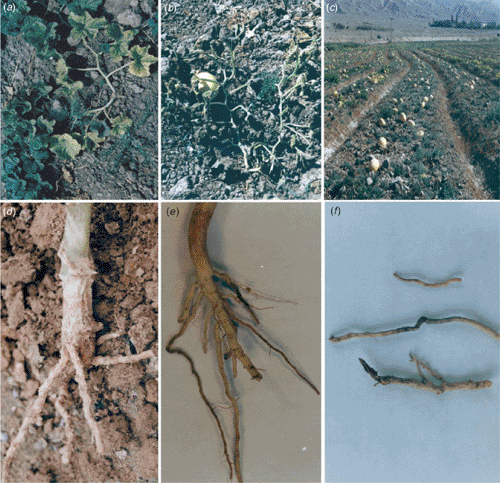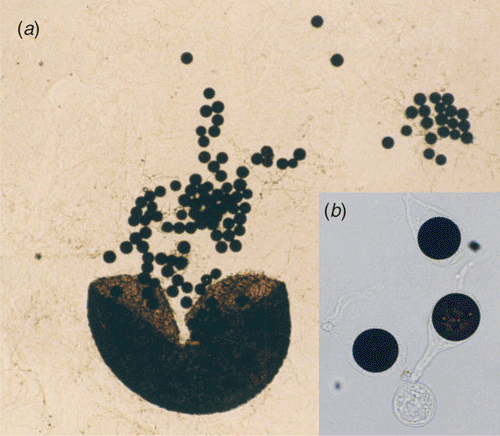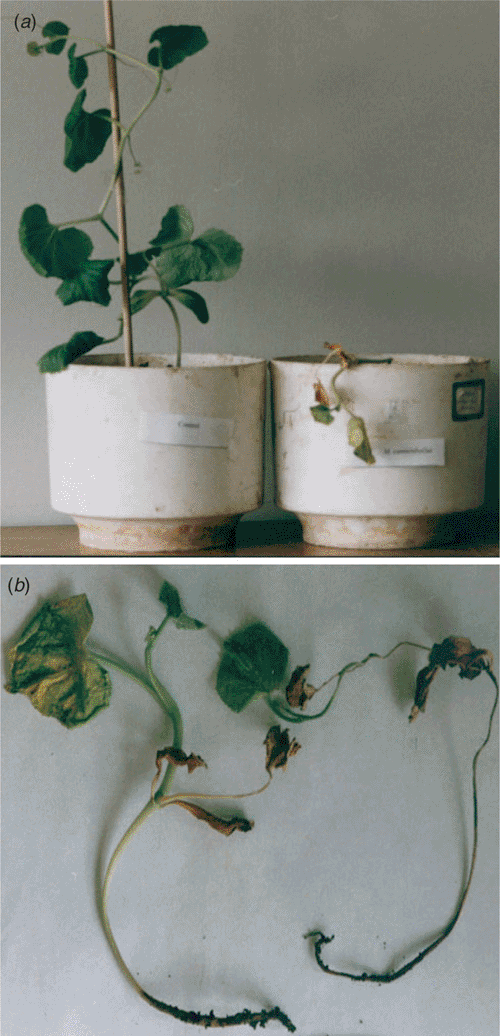The role of Monosporascus cannonballus in melon collapse in Iran
A. SarpelehPlant Disease Research Department, Plant Protection Research Institute, Evin 19395-1454, Tehran, Iran. Email: asarpeleh@yahoo.com
Australasian Plant Disease Notes 3(1) 162-164 https://doi.org/10.1071/DN08063
Submitted: 17 September 2008 Accepted: 10 November 2008 Published: 27 November 2008
Abstract
Melon collapse is an economically important disease worldwide, induced by several soilborne plant pathogens including Monosporascus cannonballus. A disease with symptoms similar to melon collapse has been observed in hot and arid regions of Iran. However, no pathogen has been yet reported to be associated with this disease. In this study, M. cannonballus was isolated for the first time from melon plants grown in Iran. Pathogenicity testing of the isolates demonstrated that M. cannonballus is one of the causes of melon collapse in Iran.
Diseased cantaloupe and muskmelon (Cucumis melo) samples were collected in 2001–02 from fields located in hot and arid regions of Iran (Garmsar, Ivankey, Zahedan and Kashan). The symptoms were first evident as general chlorosis in crown leaves (Fig. 1a) that progressed into apical leaves; followed by progressive necrosis (Fig. 1b) and collapse of the entire canopy 10–14 days before harvest (Fig. 1c). Brown spots were visible on roots, particularly at root junctions, and there was deterioration of the secondary and tertiary feeder roots (Fig. 1d, e). Fruits exposed to solar radiation (Fig. 1f) were smaller, sun scalded and had lower sugar content than fruit from healthy plants.

|
The roots of cantaloupe and muskmelon plants with these symptoms were used to isolate the suspected causal organism. The roots were washed under tap water then in 1 L of 1% sodium phosphate on a shaker for 15−20 min to remove soil (Aegerter et al. 2000). Pieces of root (3–5 mm) with brown spots or lesions were surface sterilised using 0.5% sodium hypochlorite then placed in Petri plates containing potato dextrose agar (PDA). After the plates were incubated at 25°C for up to 4 days, hyphal tips were transferred to fresh Petri plates containing either PDA or cornmeal agar (CMA) and incubated at 25°C for up to 30 days.
Fusarium solani [identification based on morphological characteristics on carnation leaf agar (Nelson et al. 1983)] and an ascomycete described as follows were isolated from infected roots. This ascomycete formed perithecia on CMA after 20–25 days of incubation at 25°C. The perithecia were globose, smooth walled and 500–520 × 340–350 µm diam. (Fig. 2a). Asci were clavate, constricted at the base, unitunicate, thick walled, 93 × 46 µm diam. and contained only one ascospore (Fig. 2b). Ascospores were spherical, smooth, unicellular, thick-walled, 35−50 µm diam. and hyaline at first, turning dark brown at maturity (Fig. 2b). No conidial stage was observed on PDA or CMA after 1 month of incubation at 25°C and the fungus grew only as septate, hyaline hyphae 2–8 µm in diam. The fungus was identified as Monosporascus cannonballus Pollack and Uecker (1974), which is being described for the first time from cantaloupe roots in Iran.

|
For pathogenicity tests, F. solani and M. cannonballus were grown on a double sterilised mixture of washed sea sand and ground oat hulls (1 : 10) in 1 L flasks (Aegerter et al. 2000). These cultures were kept at room temperature under 12 h of fluorescent light/day for 5 weeks, then used to inoculate a local variety of muskmelon named Zard-e-Garmsar using the method described by Aegerter et al. (2000) and Bruton et al. (1995). The inoculated plants were kept in a growth chamber at 30 ± 2°C and monitored daily for up to 50 days.
Isolates of F. solani did not induce any symptoms on muskmelon plants in this study (data not shown), while M. cannonballus isolates incited general chlorosis of crown leaves 25–30 days after inoculation, with general necrosis evident 40–50 days after inoculation and reduced plant growth compared with the controls (Fig. 3a). The roots of inoculated plants grew very poorly and developed dry root rot (Fig. 3b). M. cannonballus was reisolated from the roots of inoculated plants. This study demonstrated that M. cannonballus is one of the causes of melon collapse in Iran.

|
Acknowledgements
We thank Professor Jafar Ershad for his help in the identification of fungal isolates and Dr Asghar Heydari for review of the manuscript.
Aegerter BJ,
Gordon TR, Davis RM
(2000) Occurrence and pathogenicity of fungi associated with melon root rot and vine decline in California. Plant Disease 84, 224–230.
| Crossref | GoogleScholarGoogle Scholar |

Bruton BD,
Gordon TR, Davis RM
(1995) Optimum CFU concentrations for testing pathogenicity of California cucurbit isolates of Monosporascus cannonballus and an Acremonium sp. (Abstr.) Phytopathology 85, 1119.

Pollack FG, Uecker FA
(1974) Monosporascus cannonballus, an unusual Ascomycete in cantaloupe roots. Mycologia 66, 346–349.
| Crossref | GoogleScholarGoogle Scholar |



